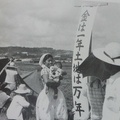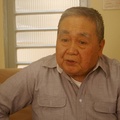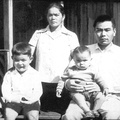On July 19, 1955, ten years after the end of the war, the land and even the houses in Isahama, Ginowan City, which was said to be "one of the most beautiful fields in Okinawa," were forcibly requisitioned by the US military. Two years later, ten families who lost their land emigrated to Brazil, an unknown country with no connections. The "Isahama Land Struggle" was an early resistance movement against the forced confiscation, and became a symbolic historical fact in the subsequent "island-wide struggle." On the other hand, little is known about the lives of the people who emigrated to Brazil. What were their thoughts when they had their land taken away and left their homeland? What thoughts did they have as they lived in Brazil? Through interviews with three groups of Isahama immigrants, we traced a part of Okinawa's turbulent modern history.
* * * * *
Casa Verde is an hour's drive north from the center of Sao Paulo. Many Okinawan immigrants live here, and there are many Japanese restaurants along the main street. Since the mid-1960s, Isahama immigrants have been relocating here from the interior of Sao Paulo State, and four families currently live here.
When I heard that there was a son and daughter-in-law of this symbolic "heroine" who fought through the Isahama land struggle, I immediately requested an interview.
The couple, Tomonori and Yukiko (85), who live in one of the largest houses in the area, treated us to coffee and pastel. Nae Tomonori passed away in 2011 at the age of 97. Tomonori, the eldest son, said, "My mother had a loud voice and was tomboyish. When we lived in Isahama, the neighbors were scared of her."
The compensation offered by the US military in exchange for the confiscation of the land was so low that the residents could not accept it. However, there were voices of fear that if they continued to oppose it, they would not receive any compensation at all. With the persuasion of the village chief, the representative of Isahama village was about to accept the conditions. The discussions were held among men only, and women were left out.
Nae Tasato was the leader of the women who heard this and rose up, saying, "We can no longer leave it to the men." There were many widows in the village who had lost their husbands in the war, and for them, the loss of their land was a matter of life and death.
Nae and about 20 other women made a direct appeal to the head of the Ryukyu government. "We cannot raise our children if we move to a place where there is not even a single farmland. Our current feelings are like being put on the gallows, waiting for our time" (Okinawa Times, evening edition, January 31, 1980). In addition to submitting petitions, they also gave speeches in the village. Their campaign was picked up by the Okinawa Times and the Ryukyu Shimpo, and became a hot topic throughout Okinawa.
Years later, Nae recalled, "When our land was taken away, I had six children.... The youngest was only one year old. My baby was crying and I couldn't leave him with anyone, so I stood on a platform while feeding him and told everyone about the situation in Isahama" (Okinawans Whose Land Was Taken by the U.S. Military, by Ishida Jintaro, Shindokushosha, 1997).
Yukiko says, "My mother-in-law wasn't afraid of anything. She even went to negotiate directly with the American military."
*This article is reprinted from the Nikkei Shimbun (March 14, 2018).
© 2018 Rikuto Yamagata / Nikkey Shimbun







